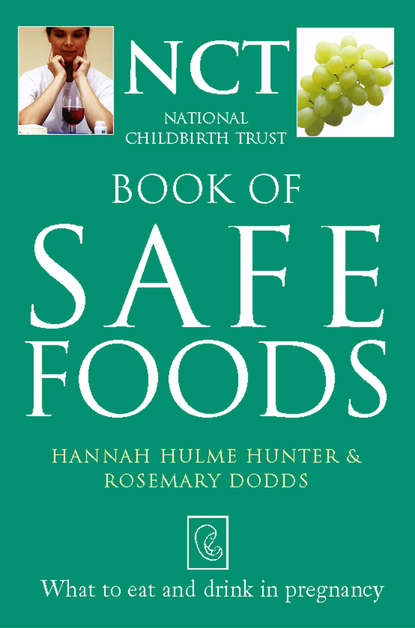По всем вопросам обращайтесь на: info@litportal.ru
(©) 2003-2024.
✖
Safe Food: What to eat and drink in pregnancy
Автор
Год написания книги
2019
Настройки чтения
Размер шрифта
Высота строк
Поля
Getting the balance right
Imagine an empty plate. Mentally divide the plate into three.
One-third will be full of energy foods: the starchy carbohydrates – pasta, potatoes, rice, yam, bread or cereals. Another third will be packed with fruit and vegetables. Divide the remaining third of the plate into three unequal sections, one a lot smaller than the other two. One of these sections is for protein foods, needed for growth and repair of our bodies – meat, fish, nuts, cooked beans and so on. The other section is for dairy products: the milk-based foods, rich in calcium and other minerals – fresh milk, yoghurt, cheese. The tiny bit in the middle is for fatty and sugary foods.
Now put some food onto your plate. Fill one whole third with rice, potatoes or pasta. Pack another third with lightly cooked vegetables. Put a small portion of fish or lean meat in one of the remaining bigger bits. In the other, put a tub of plain yoghurt. In the tiny bit in the middle, put a teaspoonful of honey to mix into the yoghurt. Pour yourself a glass or two of water. There – a balanced meal!
What about breakfast? Fill one-third of your plate with tinned grapefruit segments. Fill the next third with 2–3 slices of wholemeal toast. If you want to (and it doesn’t matter if you don’t for one meal), add an egg or a slice of lean ham. Place a glass of semi-skimmed milk in one of the smaller sections, and a pat of butter for the toast in the tiny one in the middle. Another balanced meal.
A quick working lunch? Fill one-third of your plate with a large roll of wholemeal bread. Pack the next third with some well-washed salad leaves, a sliced tomato and a crisp, green apple. In the small protein section put a hard-boiled egg or some slices of tasty Cheddar. (Don’t worry about the milk section; the cheese has taken care of that one this time.) Spread the bread roll with a small knob of low-fat spread, and wash down your meal with a carton of unsweetened orange juice.
Treats
Some women find it more helpful to imagine the plate filled with food for the whole day – or even for several days. So long as we get the balance right over about a week, that’s OK. This means that the bag of crisps we couldn’t resist in the cinema can fill up the tiny fatty foods section for several days – provided we don’t try to squeeze in extra dollops of cream as well! And the second helping of roast lamb enjoyed at the weekend can take care of our protein needs for a while, too.
But beware: many foods overlap the sections on the plate and need to be counted into both. Streaky bacon, for example, and ham with the fat still attached, will fill the small protein section – and overlap into the tiny fat section. (So no extra butter or spread for that meal.) Likewise, breakfast cereals are an excellent way of filling the carbohydrate section, but if they contain added sugar, that’s the sugar section overflowing as well. This is why it’s a good idea to choose low-fat and low-sugar foods – and leave the fat and sugar section free for the odd sweet or bag of crisps or whatever other treats we fancy.
Food choices from across the world
Wherever you come from, and whatever the origins of your choice of food, you can use these guidelines for a balanced diet. Simply decide in which group the foods you enjoy belong, and plan your meals around the same proportions described above.
In fact, we can all learn a lot about balanced eating from the food of other countries. Most Indian meals are based on plenty of rice or chapati, a vegetable curry and occasional fish or eggs. Traditional Italian meals generally involve lots of pasta, tasty tomato or milk-based sauces and perhaps a small quantity of meat. Much Chinese cooking centres on stir-fries of noodles, lightly cooked vegetables and seafood. Many traditional African meals involve plenty of starchy carbohydrate – yam, maybe, or pounded cassava – a spicy stew and green leafy vegetables.
Just one word of caution: if you also enjoy fatty foods such as chips, pies and crisps, keep a close eye on the total amount of fat in your diet.
Now let’s look more closely at the foods in each section of our plate.
What is a nutrient?
A nutrient is any substance that gives us nourishment and contributes to the smooth working of our bodies.
What are carbohydrates?
A third of our plate is packed with starchy carbohydrate foods. Carbohydrates should be the main food group that give us energy (calories). We all need energy foods, simply to keep our bodies working well. Some of us need more energy than others; a farmer, active all day in the open air, will need more energy than a secretary sitting at a desk. But even sitting and thinking uses up energy!
Caring for young children and running a home is particularly demanding work. An adequate intake of energy foods is very important, not only to give us the strength to keep going but to help us feel enthusiastic and happy doing so. During late pregnancy you need slightly more energy than at other times – but not much! It is certainly not true that you need to ‘eat for two’. We talk more about this in Chapter 5 (#litres_trial_promo).
There are two types of carbohydrates – starches and sugars.
Starchy carbohydrates
Starchy foods include things like breakfast cereals, bread, chapati, nan, pitta, rice, pasta, noodles, potatoes, yam and plantain. These foods tend to be good and filling. The energy from starchy foods is slowly converted into sugars and gradually absorbed by our bodies. This means we feel satisfied for longer.
Starchy carbohydrate foods give us more than just energy. They are also important sources of other valuable nutrients – protein, vitamins, minerals and fibre. Starchy carbohydrate foods tend to be fairly cheap to buy.
Sugary carbohydrates
Sugary carbohydrate are found in foods such as sweet biscuits, cakes, jellies, puddings and sweets. These foods are not very filling and they can be expensive to buy. Sugary carbohydrates give us a quick boost of energy, but this energy is only short-lasting so we are likely to feel hungry again soon afterwards.
Sugary carbohydrates have very little nutritional value. This is why it is best not to eat too many sugary foods. It is far better to eat plenty of the starchy carbohydrate foods mentioned above – foods that give us more than just energy. We talk more about sugary foods a little later in this chapter.
Wholemeal foods
Generally, wholemeal or brown varieties of rice, pasta, cereals and bread tend to contain more vitamins, minerals and fibre than the refined or white kinds. For example, wholemeal bread contains half as much again of some of the important B group of vitamins than the same amount of white bread – and twice as much fibre. Wholemeal foods are very useful during pregnancy, when sometimes you may not feel like eating much, because even a relatively small quantity of a wholemeal food will still give you plenty of energy and other nutrients.
Wholemeal breakfast cereals are especially good value in nutritional terms. All breakfast cereals are good energy foods, and most are fortified. (Fortified means that extra vitamins or iron have been added.) Wholemeal cereals are also particularly rich in fibre. Add milk, maybe a few pieces of fresh or tinned fruit, and you have a balanced, get-up-and-go breakfast. Many people enjoy breakfast cereals at other times of the day, too.
How much starchy carbohydrate?
Along with fruit and vegetables, starchy carbohydrates make up the bulk of a balanced diet. Try to include some starchy foods in each meal – and aim for a total of six servings throughout the day. A ‘serving’ of starchy carbohydrates is equivalent to:
2 large slices of bread
1 large bread roll, a pitta or a nan
2 Weetabix
a large bowl of breakfast cereal ‘flakes’
a large bowl of porridge
2 fist-sized potatoes or 2 pieces of yam
a portion (about 6 tablespoons) of cooked pasta
a portion (about 4 heaped tablespoons) of rice
What are minerals?
Minerals are inorganic (not living) nutrients found naturally in many foods. Iron, calcium and zinc are examples of important minerals. Minerals are necessary for many body functions, including control of the balance of fluids in our bodies, as well as strong bones and teeth. As with vitamins, it is best to get minerals from our food, rather than take supplements.
What are vitamins?
Vitamins are special substances that our bodies need in order to function normally. Vitamins occur naturally in many foods – but no single food contains all vitamins except breast milk. Only one vitamin (vitamin D) can be made within our bodies – most have to be obtained from our food. Some vitamins can be stored in our bodies while others need to be eaten each day. We only need very small amounts of each vitamin. It is best to get vitamins from our food, rather than from supplements (except for folic acid). Too much vitamin A can be harmful during pregnancy.
Why are vegetables and fruit so important?
The next third of our plate is filled with vegetables and fruit. These foods are bursting with valuable nutrients including vitamins (especially vitamin C and folic acid) and minerals. Fruit and vegetables are our main source of antioxidants – special chemicals found naturally in foods that help protect our bodies against heart disease, cancer and the effects of pollution.
Fruit and vegetables are also a good source of fibre. Fibre (also found in cereals) is the part of our food that is not digested by our bodies. It passes through our digestive system and makes up the bulk of our faeces (bowel motion or poo). Fibre plays an important part in keeping our digestive systems running smoothly and preventing bowel diseases. If we do not have enough fibre in our diet, we may become constipated (have difficulty in passing a bowel motion).
Shopping for fruit and vegetables
If you can, buy fresh fruit and vegetables. Green leafy vegetables are good sources of folic acid. Yellow fruit such as mangoes and apricots, and citrus fruits such as oranges and grapefruits, are rich in vitamin C. But the main thing is to choose fruit and vegetables that you enjoy – and eat plenty!
Try to choose clean, undamaged items, store in a cool place and wash them well at home. Fruit and vegetables sold loose tend to be cheaper than trimmed and packaged items. Some market stall holders and green grocers sell their produce off at reduced prices at the end of the shopping day. Eat fruit and vegetables within a few days, while they are still fresh. And remember that over-cooking of vegetables will greatly reduce their vitamin content – and spoil their taste.
How much vegetables and fruit?





